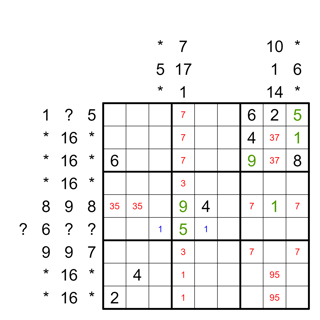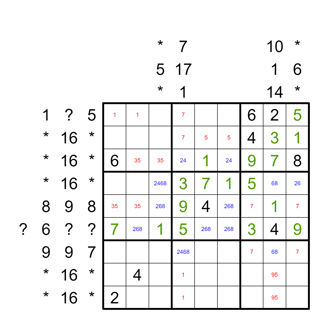Final grid:

(Click on any image for a larger, high-res version)
I will clue all completed odd digits as green to make the path a bit clearer.
Starting off near the middle
Row 6 has 4 clues, meaning that the 5 odd numbers will be split into 3 singles, and 1 double. The 6 also must be the double, and must be 1+5. Due to the groups having to be split, there are 3 cells the 1/5 pair can be in, and hence the middle cell MUST be 1 or 5.
However, this cell intersects the column with 7, 17 and 1. This means that there is a 1 towards the bottom of the column, and the cell therefore must be a 5:

Now moving towards the right
Column 8 is interesting as the pairs can only be in 1 way, 3+7, 1 and 9+5. Now the 9/5 can only be on the bottom two cells, and due to the 6 in row 6, the 1 can only be in row 5. This now gives us the pairings for row 5.
In the top right, the 5 can be in one of two places. However, if it in C7, there would have to be a gap to the left which would trap the odd number, so it must be top right with an odd number below. As there is a 6 in row 9, then it must be a 1 below. Below the 1, must be even and this can only be 8. This leaves only one place for the 6 and 9 in this box as well.
Row 7, column 4 can currently be a 3 or a 9. However, if it a 9, there is no room for the 1+3+5 required, meaning it cannot be a 9, and the 9 in column 4 must be in row 5.

Lets take a look at the rows with 16
16 can be created in two ways, 1+3+5+7, or 9+7. The way the rows work with the asterisks, both are possible for all rows, at least to start with.
For row 2, we have a 1 and a 3/7 isolated, meaning this 16 must be 9+7. For row 3, we have a 9 next to a 3/7. This must also then be a 9+7, and hence the top right box can be completed.
For the bottom two rows with 16, at least one of them is 1+3+5+7, as there is a 9 in one of the rows, but due to the 7s being elsewhere in the same box, cannot be next to a 7.
In the middle right box there is now only one place a 5 can go. This still leaves both options for the 16 in that row however.

A few more big deductions
Looking at the top 3 rows, there must be a 1 in the top two left cells. This places a 1 in row 3 column 5, as there is a 1 at the bottom of column 4. This also completes the 6 in row 6, and places another 1 in the middle box.
In row 6, there is now only one place a 4 can be placed.
Now for a big deduction: The 16 in row 4, MUST be a 1+3+5+7. If it was a 9+7, then it would have to be in the left box, however there is already a cell which must be either 9 or 7 in the same box. Hence the 16 must be 1+3+5+7. This also means the 9 must be in the middle left box, fixing a 7, otherwise there are too many evens in the box. In row 6, the missing 3 and 9 can be placed in the right middle box.

Things are beginning to fall into place
In row 5, if the 7 is on the right, that would leave the 179 triangle isolated, so it must be on the left. This gives a 26 pair in the box, solving the 68 pair in column 8.
Now in column 9, the 3 must be under 7 or it will be isolated, and this leaves a 4 at the bottom. Next to the 3 is a 9, or a 5. If it is a 9, then 16 cannot be created, so it must be a 5, solving the 95 pair.
This gives us the two 16s. The bottom 16 must be a 1+3+5+7, as a 7 cant be next to the 9, meaning an 8 must be in that cell instead. To prevent isolation, the 1 must be next to the 5, and a 7 next to that 5 and this solves the 16 in row 8.

Nearly solvable now
In row 7, the first 9 must be a 1+3+5. The 3rd cell must be the 3 as it cannot be 1 and 5 must be isolated in that column. This solves both 35 pairs further up in the grid, and in turn the 135 ordering.
There is now a 1 fixed in the top left cell, completing the 1s, and there must be an 8 to the right of it. In the 1st column, there is only one place for a 4, and that places a 9 in row 4.
The bottom 16 now must also be 1+3+5+7, and the top one a 9+7. The bottom 16 must have a 7 in the 3rd cell, as there is a 35 pair in the middle box.

You can now reach the following using normal sudoku rules, and solve after with the logic given:

To prevent isolation of the 739 in the top middle, the 5 must be in column 5. The 9 at the bottom must be above the 7 or will be isoalted. From there, everything falls into place.









